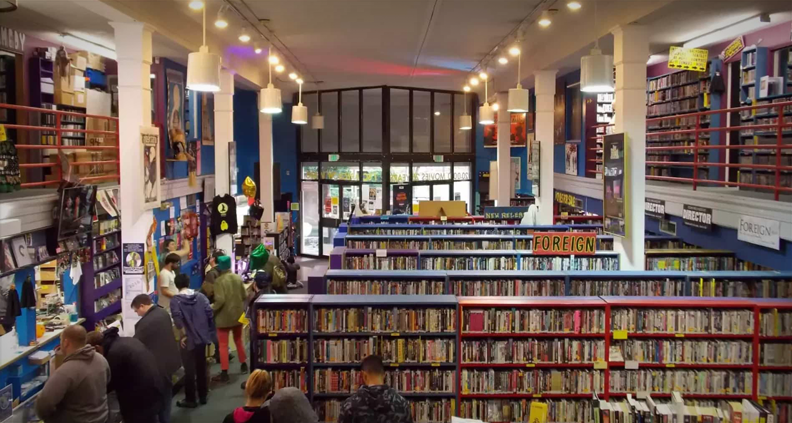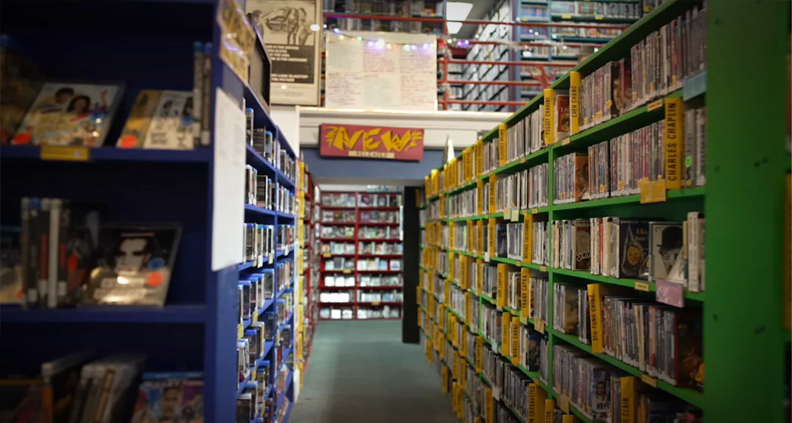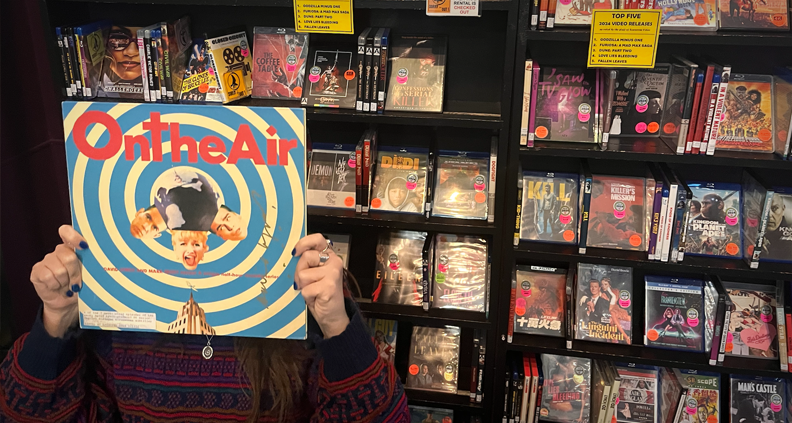Disc Jockeys: The Worlds Biggest Video Rental Store is in Seattle
Ed. Note: Disc Jockeys is a new column where we feature video stores across the country that provide their communities with access to DVDs, Blu-Rays and VHS that can and can’t be found anywhere else and where we talk about what it takes to survive as a physical media store in the age of streaming.
Scarecrow Video is a Seattle institution. Opened in 1988 by two cinephiles, George Latsios and Rebecca Ruhl Soriano, the video store build its collection up from 600 to now 147,000 unique titles (over 150k pieces in total). Of course, the path to get there wasn’t a straight one. The store thrived durring the rental boom of the 90s and had to find a way to survive the online rental and streaming revolution of the 2010s (much like Beyond in Baltimore, they are now a non-profit run by its staff).
Today, the store, and the community around it have flourished. They still offer Rent-by-Mail to movie lovers all over the country, and it’s unique collection has things that will most likely make you want to use it, like the worlds biggest bigfoot cinema collection, or David Lynch’s TV follow up to Twin Peaks, the little seen On The Air.
Jonathan Marlow started out as a volunteer for Scarecrow Video, helping open a larger location and running a micro-cinema in the store in the 90s. After some time in tech, the board of the SV Archives, which runs Scarecrow, recruited Jonathan to rejoin as the non-profit’s Executive Director. We spoke with him about Scarecrow’s journey from Mom & Pop video store to the world’s largest public video library.
Tell me a little bit about the Seattle film scene and where a Scarecrow fits into it.
The landscape of Seattle has transformed fundamentally in the last several decades. I grew-up in Lake Stevens, a town roughly an hour to the north. Not unlike many cities around the U.S. or around the world, there were many small cinemas one could attend. More recently, many have shuttered. My hometown did not have a theater but it did have a video store or two. They were all fairly modest compared to Scarecrow Video but I rented whatever I could to watch with my mother and younger brother. They did not often care for the lengthy, glacially-paced films that tended to appeal to me. Whenever I had the opportunity, I ventured into Seattle to rent films I had merely read about within the pages of publications I’d purchased at the nearby Cinema Books.
Scarecrow was founded in 1988 and they had a storefront across town from where it is located now. I became involved when they were looking to move to a larger location. I was just starting university and I’d volunteered to help move their collection—which, at the time, was just under 20,000 titles—to this seemingly enormous space in the University District.
In the decades since, the collection has expanded to 150,000 physical objects representing nearly 200,000 films and television episodes of all durations from essentially every country in the world. It is currently the largest publicly-accessible physical-media archive in the world.
The fact that such a store exists in Seattle makes sense. Seattle tends to be a place, weather-wise, where folks like to spend much of their time indoors during the late-autumn, winter and early-spring. It can be particularly wet and, occasionally, rather cold.
There had always been a desire for Scarecrow-presented events. Way-back-when, there were many presentations with the Seattle Art Museum and elsewhere. When we moved to the Roosevelt location, I built the Sanctuary Theater, the smallest operational cinema in the U.S. on the second floor (slightly less than twenty seats!), where I programmed films unavailable on home video, until 1998. Event-wise, outside of Sanctuary, Scarecrow had been a largely itinerant institution. It regularly partnered with other spaces, like the soon-to-be-reborn Grand Illusion.
There are a number of really remarkable cinemas in town. The Beacon, of course, and Central Cinema. Northwest Film Forum, where I’ve regularly presented screenings even after I moved away. There are many great microcinemas which have changed the landscape of film-going since the multiplexes have largely failed everyone by primarily providing unchallenging work.

Tell me a little bit about what being the Executive Director of Scarecrow entails for you.
I was recently recruited by the Board of SV Archive (aka Scarecrow Video) and, like any small nonprofit, I do a little of everything. Fortunately, I am able to accomplish these things in collaboration with a team of truly wonderful people. I am primarily responsible for making certain that this activity which many individuals view as irrelevant and outdated—the renting of Blu-rays, DVDs, VHS tapes and laserdiscs—is instead understood to be an essential alternative to the various streaming platforms.
This notion that what we do is antiquated is a conflict of public-perception. Streaming is discussed as the solution to every problem and everyone wants to believe that everything is available online. It isn’t and they aren’t. The assumption from some is that this is merely older individuals who never adapted to streaming. The truth is that majority are young people unsatisfied with the limited options that streaming offers. Why choose from such a nominal selection? They want to watch what they want when they want without multiple subscriptions. Scarecrow has more films and series than all of the assorted streaming services combined! More people are renting now than they did a year ago and, in another year, more people will be involved than are renting right now. It is about discovery and access and choice. There are far too many things that you cannot see any other way.
Scarecrow started out as a traditional store and then went through some changes in ownership throughout the years, and then finally became a nonprofit. How did that transition take place?
The short version is that Carl Tostevin and Mickey McDonough bought the store from George and Rebecca, the original owners. That occurred shortly after I disappeared from the Pacific Northwest but I was fortunate to get to know them. Whenever I ventured to Seattle, I would always make a point of visiting the store to see how things had changed (or not) over time.
Mickey and Carl did an amazing job of keeping everything functioning while the everything was shifting away from physical-media rental. During the early days of rent-by-mail, I was involved with GreenCine, an early Netflix competitor in the Bay Area and later, as one of the co-founders of Fandor. I was very familiar with what we were doing there and how that impacted Scarecrow’s core business.

By the early-2010s, it was clear that the for-profit model—entirely reliant on rental and sell-through income—was a challenge for Scarecrow to maintain. In many respects, they kept it going far longer than many others in the space. With the understanding that nonprofit status would open new avenues for funding, the owners initiated a request-for-proposals. One of those proposals came from the staff.
Ultimately, Carl and Mickey accepted the staff-proposal to allow them to transform the for-profit. They generously donated the inventory to the Scarecrow Project rather than selling it, putting the nascent non-profit in an incredible position from the very beginning.
I’m curious about your rent-by-mail program. That’s something that feels like it’s unique, especially in the modern video store space. How does that work and why did you decide to do it?
The one thing with a collection of this magnitude, especially when Netflix pulled the plug on rent-by-mail and my former company, GreenCine, stopped renting films through the mail even earlier. There aren’t many other avenues for viewers to get DVDs, Blu-rays or UHDs by mail without buying them.
Building your own home-video collection is fantastic (if you can afford it) but there are those films that you do not necessarily know that you’d want to own forever. Maybe you’re just curious about seeing it once. We introduced a rent-by-mail process a handful of years ago as an alternative to requiring renters to make their way into the store. Those efforts are growing and they’re evolving.
We have a fairly large contingent of renters from the opposite coast but those efforts can be complicated by the inconsistencies of the United States Postal Service. They’re not exactly the most reliable under the current administration. It can take a bit of time to get discs to Brooklyn or Boston or even to Dubuque or Durham. We’ve basically built-in extra time to accommodate renters who reside farther away. Fortunately, the collection is immense enough that it doesn’t impair availability for individuals who are regularly renting in-person from the store.
What are some types of films or specific films that you’re proud that Scarecrow has? What’s something that you’re personally really excited about?
I am primarily thrilled with the entirety of the collection! We still have laserdiscs when they have features which are unavailable on other formats. We maintain our VHS selections for those titles that have never been released on another format. There is a bit of overlap in our Blu-ray, DVD and UHD / 4K titles since not everyone has a player that supports each codec.
Even going back to the beginnings of Scarecrow, the original owners—George Latsios and his partner, Rebecca Ruhl Soriano—were determined (unlike Kim’s Video in New York, for example) that everything in the collection was legitimate. Scarecrow has stayed away from bootlegs from the start and that dedication to only adding country-of-origin releases (and renting the players to allow those to be viewable) has always been a grand model. We have many imports for films otherwise undistributed in the U.S. but nothing particularly grey-area. Definitely the opposite of what you find in massive quantities on YouTube and elsewhere, rife with bootlegs and questionable copyright issues.
For instance, we have a Japanese laserdisc of the television series David Lynch and Mark Frost created after Twin Peaks called On the Air. ABC largely disowned the series and only a few of the episodes aired in North America. Thus far, the primary way to see the series is this Japanese import.
I remember watching it when it debuted and I thought it was absurd and immensely entertaining. I was clearly in the minority. Perhaps not as “out there” as Twin Peaks: The Return but fascinating, nonetheless.
There are many imports on either PAL tape or PAL imported DVDs, works which you are unlikely to find elsewhere. The Jean-Luc Godard television series Histoire(s) du Cinéma presented a complication for U.S. distributors due to the unusually large number of clips requiring rights-clearances. There wasn’t much of a state-side release but there is a PAL four-disc set (and an NTSC two-disc version). Fairly incredible and highly recommended! I am delighted that we have it, along with rarities from Larisa Shepitko, Apichatpong Weerasethakul, Lotte Reiniger, Céline Sciamma, Souleymane Cissé, Věra Chytilová, Raúl Ruiz, Jan Švankmajer (with Eva Švankmajerová) and many others.

Why are video stores still important?
You know, it is a really great question. You’re calling from Los Angeles, right?
Yeah.
In just the last few years, Vidiots reopened from their original Santa Monica location to their current space [in Eagle Rock]. I think of Vidiots, primarily, as an amazing cinema with a microcinema and video store attached. Fortunately, the video store is also terrific! I adore that they’re committed to their video store past.
There are other video stores across the continent as well. There is We Luv Video in Austin and Beyond Video in Baltimore, entirely volunteer-operated. There is a bit of a resurgence for video-rental! Like the premature declaration of the death of vinyl and the subsequent reappearance of record stores, video stores and independent bookstores have thrived as well.
The challenge is that there really isn’t an ideal system in-place to deal with video rental at the moment (from a software perspective: we built our proprietary version). Once upon a time, video stores were everywhere. In the Seattle area, there were several fabulous video stores—in addition to the Scarecrow—that survived up until the second decade of the century. They were hanging in there. In our neighbourhood, we’re all that is left.
I’m encouraged that Movie Madness in Portland, Oregon, continues to thrive. They have a small screening space in their building which seems to get rather frequent use. I hadn’t had an opportunity to get back there since the start of the pandemic but I visited last week and it is still rather fantastic. On a weekday, it was full of people wandering around, renting videos. The same thing happens at Scarecrow every day.
Many people who walk through our front doors cannot believe that this could be real. It is a true citadel of cinema! They look around and it is packed full of people renting videos. It is almost as if they’ve opened the doors and were allowed to take a giant leap back in time to the late-1980s or ‘90s. However, the options of what is available is far better than the previous century. This is largely thanks to the small labels like Deaf Crocodile, Arbelos, Grasshopper Film, Dekanalog and others. Obviously, the Criterion Collection releases regularly have substantial appeal as well. KimStim in New York continues to release astonishing films, such as Subete no yoru o omoidasu [Remembering Every Night] and La casa lobo [The Wolf House]. You’re not likely to find those films on the most services, generally. If you have any taste whatsoever, physical media remains your ideal solution.
***
For over 40 years, Film Independent has helped filmmakers get their projects made and seen. The nonprofit organization’s core mission is to champion creative independence in visual storytelling and support a community of artists who embody diversity, innovation and uniqueness of vision.
Film Independent Members watch nominees and vote for the winners of the Spirit Awards. To become a Member of Film Independent and make your vote count for next year’s 40th Annual Spirit Awards, just click here. To support our mission with a donation, click here.
Keep up with Film Independent…
